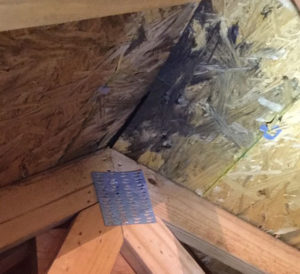
Table of Contents
Is wood mold dangerous?
Yes, wood mold can cause allergic reactions to some people. Although mold may not be dangerous in itself, it may produce various toxins that fill the air. It is rare to come across an aggressively toxic wood mold. Wood mold may appear as a discolored layer on the wood. In high concentrations, the spores produced will fill the air in your home and cause allergic reactions to sensitive people.
Exposure to wood molds may cause symptoms such as:
- Sore throat
- Coughing
- Sneezing
- Fatigue
- Watery eyes
Wood mold may grow behind specific structures in your home and penetrate the air through air vents. The concentration of mold in your air will cause adverse respiratory diseases such as tuberculosis and fungus lung inflammation.
What does black mold look like on wood?
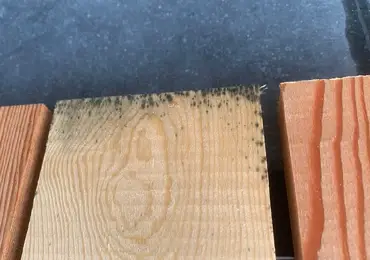 Detecting black mold on wood may be somewhat tricky due to the wood pattern and patches. Identifying the right color of the wood will help you look for a darker shade on the wood surface. Black mold may grow on either side of the wood before spreading to other parts in circular patterns. Black mold will flourish under damp or moist areas before expanding to much larger areas. Thus, when looking for black mold, check for areas with a high concentration of moisture and dark greenish colors spreading to other areas. Another way to identify black mold on wood is through the pungent odor that comes from the mold.
Detecting black mold on wood may be somewhat tricky due to the wood pattern and patches. Identifying the right color of the wood will help you look for a darker shade on the wood surface. Black mold may grow on either side of the wood before spreading to other parts in circular patterns. Black mold will flourish under damp or moist areas before expanding to much larger areas. Thus, when looking for black mold, check for areas with a high concentration of moisture and dark greenish colors spreading to other areas. Another way to identify black mold on wood is through the pungent odor that comes from the mold.
When inspecting for black mold in your home, ensure that you cover your nose, eyes, hands, and mouth covered. It is because of the natural toxins contained in the black mold that may cause adverse respiratory problems.
Causes of black mold growth
In order for mold to grow on any surface, but especially wood, moisture must be present. In homes and other buildings, moisture build up can be caused by many different things. If you have a large household, you have a better chance of finding the black fungus; when we breath we give off moisture. Additionally, hot showers and even cooking can contribute to the moisture-level in homes. However, moisture build-up can also occur from certain malfunctions in your home. Black mold can show up after you’ve had a leaky roof or pipes as any moisture that is trapped can turn into black mold.
Poor placement of fans
Poor placement of fans can be another factor that leads to black mold growth. Often, kitchen, dryer and bathroom vents may be opening up into an area of your house instead of outside. This allows damp to build up inside of your house which can lead to black mold growth. One of the most common causes of black mould growths in homes is poor ventilation. Additionally, a large variety of building materials actually provide the perfect nutrients to aid black mold growth, which would explain why black mold on wood is extremely common.
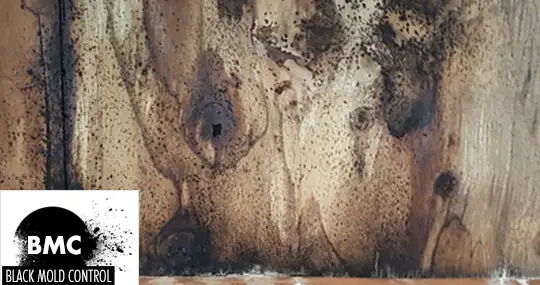
What kills mold on wood?
When fungi grow on wood, its roots remain deeply attached into the wood fiber even after scrapping the outer, visible surface. However, these following 5 steps should help you kill the black mold on your wooden floors, furnishings and surfaces.
- Step 1: Select a cleaning solution
You want a solution that will penetrate the surface of the wood and remove or kill the fungi. Regular cleaning detergent, distilled vinegar, bleach, rubbing alcohol and a good commercial fungi removal product may do the trick. Be sure not to combine the bleach with any product that contains ammonia. It could blow into some toxic fumes that could kill you or cause deadly infections. - Step 2: Put on protective gear
Depending on the concentration of the cleaning solution you choose, you might want to put on some protective gear such as rubber gloves, a respirator, safety goggles, and coveralls, if available. - Step 3: Scrub affected site with the cleaning solution
Using a clean low-abrasive brush or scrub pad, you will apply the cleaning solution to the area affected with black mold. Scrub the area gently in circular motion until you remove the black color. Move to other areas and repeat the process until you remove the fungi from the wood’s surface entirely. - Step 4: Sand the area
As earlier mentioned, mold roots can be deeply engraved in the wooden material. To prevent re-growth, your goal is to remove all the fungi roots. Here’s where the sanding process comes in. After sanding the area lightly, repeat the step above where you scrub with the cleaning solution to ensure the plucked roots and spore residues wash away. - Step 5: Let it dry
After you remove and kill the black fungi, collect any residue or items that have come into contact with the fungi and discard them. Clean the area with new and uncontaminated items to prevent spreading the fungi again. Let it dry by placing it in a nicely ventilated and dry area. Give it all the time it needs to look and feel dry.
Best ways to remove mold from wood
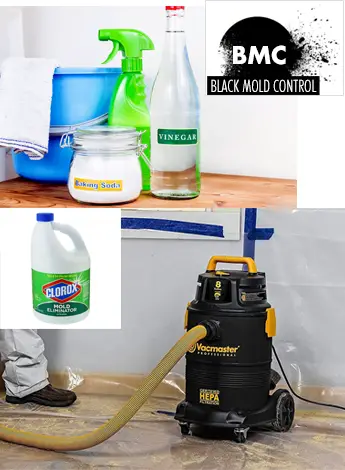 Because black mold on wood can cause harmful health affects, is unsightly, and can potentially weaken wood structures, it is very important to remove it as soon as possible. Although black mold removal may seem daunting, the job can be completed with just a few steps. There are several techniques that can be used for to remove black mold from wood.
Because black mold on wood can cause harmful health affects, is unsightly, and can potentially weaken wood structures, it is very important to remove it as soon as possible. Although black mold removal may seem daunting, the job can be completed with just a few steps. There are several techniques that can be used for to remove black mold from wood.
Water and detergent
Perhaps one of the simplest is using hot water and detergent. Follow these steps if there is little mold. First, make sure that your detergent does not contain ammonia. Next, scrub the whole fungus surface with a stiff scrub brush, hot water, and the detergent. Be sure to sponge, mop, or vacuum any remaining water from the wood.
Afterwards, use clean hot water to rinse the wooden surface. It’s imperative to dry the wood to be sure that no moisture remains. It can also be a good idea to thoroughly disinfect the area using a mixture of water and bleach to ensure that all mold spores are gone.
HEPA vacuum
Another method of removing black mold from wood is to use a High Efficiency Particle Air (HEPA) vacuum. These vacuums can be used after the above steps. A HEPA vacuum is good to use in order to make sure that all mould particles have been removed. This can include dust they may have accidentally been spread during your initial cleanup of the black mold. Be advised that if you have fungus in a carpet or mattress, it can be extremely hard, if not impossible to get rid of. In those cases, it may be best to dispose of the contaminated objects.
How to clean mold off wood?
Cleaning mold off a wood surface can be quite intense, given the heavy-duty scrubbing. Make sure you wear protective clothing to prevent exposure to mold spores. In this guide you will learn 4 ways to get rid of the mold on your wooden surfaces.
Vacuum
Vacuum the affected area to get rid of loose mold spores.
Spray Vinegar
Read our detailed guide: how to get rid of mold with vinegar below.
Warm water and home detergents
In case the wood surface is stained or painted, then the growth may not be extensive. Thus, cleaning with home detergents and warm water will work. Scrub the affected area with a brush. Wipe down with a damp towel and inspect for remaining mold.
Diluted bleach
Use diluted bleach to spray the affected area. Allow the bleach solution to soak in and air-dry on the surface. If persistent, you may also use sandpaper to scrub the affected area.
How do you get rid of mold with vinegar?
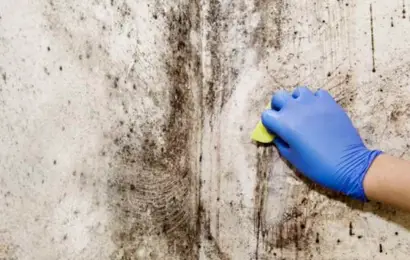 You should assess the intensity of the mold growth before attempting any cleaning. Substantial growth will call for cleaners to get rid of the mold. However, for a small mold problem, you may consider it as a simple DIY task using white vinegar.
You should assess the intensity of the mold growth before attempting any cleaning. Substantial growth will call for cleaners to get rid of the mold. However, for a small mold problem, you may consider it as a simple DIY task using white vinegar.
- Step 1: Protect yourself
Ensure that you have white vinegar in your home. Wear protective clothing to cover your hands to avoid prolonged exposure to vinegar. Cover your mouth, eyes, and nose as well to avoid breathing in the mold spores. - Step 2: Fill a Spray Bottle with Vinegar
Find a spray bottle and fill it up with the white vinegar. Use concentrated vinegar as mold can be a resisting force. Also, ensure that you have an adequate amount of white vinegar to spray on the surface that requires cleaning. - Step 3: Spray the Vinegar on Affected Areas
Spray the affected area thoroughly with vinegar. Ensure that the area is well covered with vinegar. If you don’t have a spray bottle, you can use a wet cloth soaked in vinegar to scrub the affected area. - Step 4: Allow the Vinegar to Soak
It takes a little time for the vinegar to absorb and break the mold. Thus, you can let it sit for about an hour before you begin scrubbing. - Step 5: Scrub the Mold Away
Use a brush with warm water to scrub off the mold. The scrub brush will make it easier to break the mold. Use an appropriate brush size to clean the area. Rinse and wipe the affected area with warm water. If the mold persists, you can repeat the processes or hire a professional.
Mold on wooden furniture
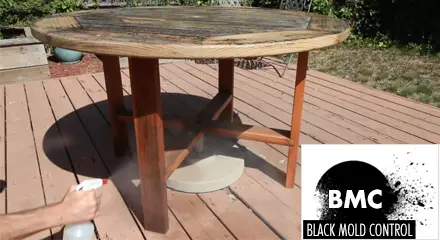 Fungi spores are a constant part of our indoor and outdoor surroundings. Unfortunately, they carry no good with them. Your wood furniture may come under attack from these fungi eventually causing damage as well as health complications. Wood furnishings are high prone victims of mold attack if exposed to certain temperatures and moisture levels. Mold survives on any cellulose-based matter, in which wood furniture provides. If any of your outdoor or indoor wooden furniture starts to home fungi, you might want to know how to remove it.
Fungi spores are a constant part of our indoor and outdoor surroundings. Unfortunately, they carry no good with them. Your wood furniture may come under attack from these fungi eventually causing damage as well as health complications. Wood furnishings are high prone victims of mold attack if exposed to certain temperatures and moisture levels. Mold survives on any cellulose-based matter, in which wood furniture provides. If any of your outdoor or indoor wooden furniture starts to home fungi, you might want to know how to remove it.
How to remove mold from wood furniture?
Here are a few steps to help you get rid of mold from your wood furniture.
- Step 1: Wear Protective Clothing
Cover your face and hands to avoid mold spores. - Step 2: Take the Furniture Outdoors
To avoid the mold from spreading indoors, take the affected furniture outside for cleaning. - Step 3: Spraying the Affected Areas
Sunlight will prove useful in fighting light mold. You can use vodka to spray the affected areas as you scrub. You may also spray the problematic areas with vinegar and allow it to sit in. - Step 4: Scrub
After spraying the mold areas with vinegar or vodka. Scrub the area with soap, warm water, and a scrub brush. After scrubbing, wipe the area with a damp towel and let it dry.

Black mold on wooden floors
Black mold manifests itself in the form of black spots. If you have wooden floors, you probably should be on the lookout for these toxic and damaging fungi. When your wooden floor comes into contact with moisture, it creates an excellent breeding ground for fungi growth. It does not only stain the floors but also growths beneath the surface and causes wood discoloration, rot, and warp. Immediate attention is paramount to prevent extensive damage and kill the black mold. Take a look at our in-depth guide to remove mold from floors.
How to remove mold from wood cabinets?
First, check whether you can dismantle the affected wood. Look out for other affected areas in the cabinets. Second, ensure that you have a supply of vinegar and make sure that you have protective clothing. Clear everything in the cabinets and take it outside. Spray the vinegar onto the mold and let it soak in for an hour. Scrub the affected areas with a brush and other cleaning products to break the mold. Finish, rinse and wipe with warm water and allow the wood to dry.
How to treat mold on wood studs?
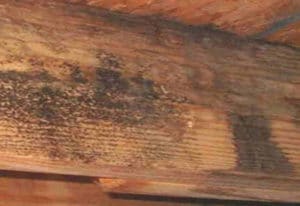 It’s easy to know how to treat mold on wood studs if you know what to do. Follow these simple four steps to sanitize the wood. Step one is wearing protective clothing and ensure that your face and hands are well covered. The second step is to ensure that you have enough cleaning products, and that includes detergents and scrub brushes. In the third step you’ll wash the wood stud with detergents and scrub the surface thoroughly. Rinse the surface with clean water. Finally, sanitize the wood surface with a mixture of chlorine and water. Allow the wood to dry thoroughly to prevent the growth of mold.
It’s easy to know how to treat mold on wood studs if you know what to do. Follow these simple four steps to sanitize the wood. Step one is wearing protective clothing and ensure that your face and hands are well covered. The second step is to ensure that you have enough cleaning products, and that includes detergents and scrub brushes. In the third step you’ll wash the wood stud with detergents and scrub the surface thoroughly. Rinse the surface with clean water. Finally, sanitize the wood surface with a mixture of chlorine and water. Allow the wood to dry thoroughly to prevent the growth of mold.
Prevention
The best way to prevent black mold from growing on wood and other surfaces in indoor buildings is to make sure that there is proper ventilation and that all fans are placed so that the damp they blow out is going outside and not somewhere inside of the building. Also, if you know that a building has been through any type of water damage, or flooding, it is advised to use one of the above methods to make sure that no moisture is trapped in tricky wood areas that may lead to black mould growth in time. Keep in mind that this fungi thrives with humidity and moisture. It can be helpful to use a humidifier in your home to prevent black mould growth.
Protective gear
Unfortunately, the removal of mold can be dangerous to those who are extremely sensitive to allergens. Therefore, it is best to use protective gear in abundance. For eye and skin protection, gloves that are long and extend up to the forearm should be used to prevent any skin irritation from not only the fungus, but also cleaning products such as bleach. It is best to use “heavy duty” gloves that are made out of rubber or neoprene. For the eyes, safety goggles that don’t have holes should be worn. In certain situations, where heavy amounts of black mold are present, it may be necessary to even wear a full face respirator.
Which respirator to use?
The type of respirator used should be dependent upon the amount of mold in the area you are cleaning. For example, if there is only a small amount of mold, a respirator that only covers the nose and mouth should be sufficient. This type of respirator can be found in most stores. However, if there’s a heavier amount of mold, a half or full face respirator should be used. Again, depending on the amount of mold you are having to remove, disposable clothing may be worn to prevent mold spores from landing on your clothes.
When removing black mold, remember to use caution and follow all gathered tips for selecting the proper protective gear for your situation.

